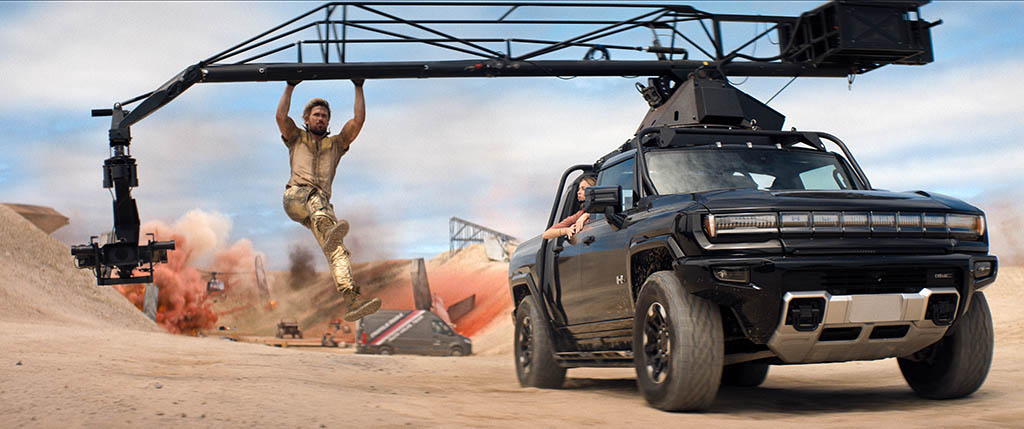
STUNTS, SFX, PRACTICAL AND VFX TEAM UP TO IGNITE THE FALL GUY
www.vfxvoice.com
By CHRIS McGOWANImages courtesy of Universal Studios, except where noted.In The Fall Guy, Colt Seavers (Ryan Gosling) a stunt double for action star Tom Ryder (Aaron Taylor-Johnson) suffers a horrific accident in a 12-story stunt fall in a building atrium. While recovering, Colt withdraws from both the film business and camera operator Jody Moreno (Emily Blunt), with whom he had been having an on-the-set romance. Eighteen months later, Colt re-emerges when Toms producer Gail Meyer (Hannah Waddington) invites him to do stunt work on Metalstorm, an epic sci-fi movie directed by Jody, whose career is taking off, and starring Tom. However, when Colt arrives at the shoot, he learns that Tom has gone missing. Gail tasks Colt with finding him or the studio will pull the plug on Metalstorm and, with it, Jodys ambitions. Meanwhile, Colt is doing all that he can to win back an aggrieved Jody.Stuntman Colt Seavers (Ryan Gosling) is suspended from a camera crane attached to a pickup driven by director Judy Moreno (Emily Blunt) in The Fall Guy, directed by former stuntman David Leitch.The plot of Universals The Fall Guy allows for a smorgasbord of dangerous feats, including a 150-foot fall out of a helicopter, a 225-foot truck jump, and a world record of 8 car cannon rolls. It is a spectacular ode to stunt work inspired by the 80s TV series of the same name. The frenetic action is directed by former stuntman David Leitch (Atomic Blonde, Deadpool 2, Bullet Train). While The Fall Guy is a tribute to old-school stunts, it is also proof that stunts, practical effects and visual effects can live harmoniously together.The over-the-top VFX for the Metalstorm movie-within-a-movie included fighting aliens, explosions and spacecraft. Flying through the air, leaping and sword-wielding were made possible by rigs and wires that were later painted out.David [Leitch] knows how to use VFX in his films to help the story. We had one rule when it came to the VFX on The Fall Guy Dont. Touch. The. Stunt. Everything else in the frame was pretty much fair game if it helped tell the story. The movie is stunt driven, a movie about a stuntman directed by a stuntman. The stunts are real. Thats the whole heart and soul of the film.Matt Sloan, Production VFX SupervisorProduction VFX Supervisor Matt Sloan comments, Working with David [Leitch], he is hugely inclusive and knows how to use VFX in his films to help the story. We had one rule when it came to the VFX on The Fall Guy Dont. Touch. The. Stunt. Everything else in the frame was pretty much fair game if it helped tell the story. The movie is stunt driven, a movie about a stuntman directed by a stuntman. The stunts are real. Thats the whole heart and soul of the film.To work on a movie inspired by a cult classic like The Fall Guy was a great experience, says Cinesite VFX Supervisor Jennifer Meire. The original series was known for its practical stunts and effects, so there was a delicate balance to strike between honoring the nostalgic elements and incorporating the more modern visual effects. She adds, Director David Leitchs background as a stunt performer and action designer brought a valuable perspective to the creative process, which led to some seriously mind-blowing action sequences. He and Matt Sloan had a clear vision for how the visual effects could enhance the storytelling and action sequences, and their expectations were focused on achieving a seamless integration of practical and digital effects to create great shots.The Fall Guy focused on executing difficult old-school stunts and practical effects that were cleaned up and amplified with the help of VFX.The Fall Guy was written by Drew Pearce and produced by Kelly McCormick, Guymon Casady, Gosling and Leitch. Jonathan Sela was Director of Photography, David Scheunemann helmed Production Design, Dan Oliver was Special Effects Supervisor and Chris McClintock served as Production VFX Producer. Contributing visual effects studios included Framestore (VFX Supervisor Nicolas Chevallier), Rising Sun Pictures (VFX Supervisor Matt Greig), Crafty Apes (VFX Supervisor Jordan Schilling), Opsis (VFX Supervisor Tefft Smith II) and Cinesite (Meire). Colt Seavers (Ryan Gosling) surfs with sparks flying on a tailgate across the Sydney Harbour Bridge in Sydney, Australia.[For the 225-foot truck jump] Logan Holladay jumped that car across the canyon on set. Utterly terrifying to watch. Naturally, there were a ton of cameras on that shot. For The Fall Guy movie [not Metalstorm] we cleaned a bunch of cameras out along with some crew vehicles and some distracting power lines in the BG. The Jody double got such a shock when the car suddenly roared over her that she did not pan her prop camera, so we fixed that as well. It was a perfect example of VFX being used to support a 100% real stunt.Matt Sloan, Production VFX SupervisorFor his work on The Fall Guy, Chris OHara received the first ever Stunt Designer credit from the Screen Actors Guild and Directors Guild of America. The recognition is well overdue, according to Sloan. If you think VFX has it bad when it comes to under-recognition, its nothing compared to the stunt department. These guys work hard. Like really hard. The planning and prep that went into the stunts on The Fall Guy were insane. Its a long and meticulous process, and it should be that shit is really dangerous. On top of that, the daily discipline required to maintain the levels of fitness and agility for each stunt performers skill set is incredible.Trucks on the beach readying for a cannon roll, which set a world record at 8 vehicle rolls. (Photo: Eric Laciste)Sloan continues, Of course the math part isnt sexy, so youll never really see that stuff in any of the behind-the-scenes footage. You just see a guy flying through the air, and you think, That looks cool. But in the end, the designer takes responsibility for a series of decisions and calculations that, if incorrect, could result in a member of their team and usually a friend being seriously injured or worse. Designing stunts is a high-stress, serious job and deserves any and all recognition that comes its way.Director David Leitch, left, readies a helicopter stunt with Ryan Gosling onboard for a Metalstorm sequence. (Photo: Eric Laciste)The Fall Guy had several death-defying stunts. The 225-foot truck jump was practical, Sloan says. Logan Holladay jumped that car across the canyon on set. Utterly terrifying to watch. Naturally, there were a ton of cameras on that shot. For The Fall Guy movie [not Metalstorm] we cleaned a bunch of cameras out along with some crew vehicles and some distracting power lines in the BG. The Jody double got such a shock when the car suddenly roared over her that she did not pan her prop camera, so we fixed that as well. It was a perfect example of VFX being used to support a 100% real stunt.Because the original Fall Guy TV series was known for its practical stunts and effects, Cinesite VFX Supervisor Jennifer Meire aimed for a balance between nostalgic elements and modern VFX. (Images courtesy of Cinesite and Universal Pictures)The high back-fall was again, real, Sloan explains. Troy Brown back-flipped from a helicopter and fell 150 feet into an airbag. Watching that happen in front of you is incredibly unnerving I did not realize I was holding my breath until the thumbs up came from the bag. Pure spectacle. VFX-wise, for safety reasons, we used a static helicopter buck as the platform for him to jump off. We replaced the helicopter buck so it could still be spinning in continuity with the rest of the sequence and added smoke from the gunshot damage. We did not touch the stunt itself!The Metalstorm shots were the antithesis of The Fall Guy, Massive, overwhelming VFX silliness. We threw everything in there. Fighting aliens, explosions, spacecraft and we even blew up the moon why not! A lot of the Metalstorm shots were shot deliberately as Metalstorm shots, but some were not. We had a VFX team getting data with cams and ref on pretty much every shot on the film because we really did not know on a shot-to-shot basis where we would have to step in.Matt Sloan, Production VFX SupervisorStunt double Ben Jenkin in flames on the set of The Fall Guy. Backup with a fire extinguisher is at the ready. (Photo: Eric Laciste)Each sequence is a series of different shots, each with its own VFX or stunt considerations, Sloan remarks. At the beginning of production, I told Chris [OHara] that I did not care how many wires/support equipment we needed to paint out as long as it was safe. He was great at minimizing the work we needed to do, but there were instances where we had a huge amount of rigging to remove, especially if it was Ryan and not one of the doubles. We opted for bluescreen for a lot of the interior car work; to shoot that practically would be too costly in terms of time. Time is the most expensive asset you have when you are shooting. David is super aware of this, and shooting that material on stage was just economically sensible. The work is perfectly serviceable to the story, and we could utilize that time-saving for larger, more complex shots/sequences. There was other bluescreen work on and off throughout the movie. Sloan notes, Our grip team had a bunch of fly-in screens that we could run onto the set if something came up that required them. In saying that, this movie used less bluescreen than any other Ive been involved in. [Yet it] also used more roto than any Ive been involved in!The stunt structure with wires for Ryan Gosling`s 12-story fall inside a building atrium.When it came to post-production [on the Metalstorm shots] and we started fleshing out the shots, it just kept going bigger and bigger. I always loved the telling silence from Nicolas Chevallier, our [VFX] Supe at Framestore, on our calls each time we would increase the scope in these shots. More explosions!, More aliens!, More lasers! and, of course, The moon should explode on frame 67. They took it in stride and produced some very fun and technically spectacular shots.Matt Sloan, Production VFX SupervisorThe use of visual effects was extensive for the movie within the movie. The Metalstorm shots were the antithesis of The Fall Guy, Sloan explains. Massive, overwhelming VFX silliness. We threw everything in there. Fighting aliens, explosions, spacecraft, and we even blew up the moon why not! A lot of the Metalstorm shots were shot deliberately as Metalstorm shots, but some were not. We had a VFX team getting data with cams and ref on pretty much every shot on the film because we really did not know on a shot-to-shot basis where we would have to step in. When it came to post-production and we started fleshing out the shots, it just kept going bigger and bigger. He continues, I always loved the telling silence from Nicolas Chevallier, our [VFX] Supe at Framestore, on our calls each time we would increase the scope in these shots. More explosions!, More aliens!, More lasers! and, of course, The moon should explode on frame 67. They took it in stride and produced some very fun and technically spectacular shots.One of the most dangerous stunts in the film is a 150-foot fall out of a helicopter. Here, Gosling hangs from a helicopter buck to capture the shot, though it was stuntman Troy Brown who back-flipped from a helicopter and fell 150 feet into an airbag.For Sloan, the Bin Truck chase was the most challenging sequence involving VFX. It was an incredibly complex, fast-moving sequence that made us utilize pretty much every trick we had, he says. We had multiple driving rigs, vehicles, doubles, locations and, of course, massive stunts. Face replacements, CG vehicles, background changes, adding sparks, huge rig removals. Added to that, we were shooting multiple cameras, so you never knew which angle was going to land in the cut. Some were great, and some were absolute monsters of roto and prep. There was a huge amount of work in that sequence, and the Framestore team did an amazing job.The third act with the helicopter work was a close second for most challenging, Sloan says. We utilized [a] helicopter buck for the majority of the sequence, and Rising Sun Pictures absolutely rose to the challenge, adding rotors, downwash, rotor flicker, smoke, explosions and backgrounds. Matt Greig and his team in Australia did some stellar work there.Face down in the sand for a Metalstorm sequence, Gosling gets flames added to his back courtesy of VFX, for safetys sake. (Images courtesy of Cinesite and Universal Pictures)Cinesite delivered over 350 visual effects shots to The Fall Guy, according to Meire. She notes, Fire was an important theme for much of our work, including a fire-breathing shot, a sequence where Colt is set on fire in a movie set stunt and a dramatic boat-chase explosion. Throughout our fire-related VFX, we utilized advanced computational fluid dynamics solvers and combustion models to simulate the turbulence of the flow of gasoline or relevant gaseous fuel. In addition, we generated realistic turbulence and heat release.Although the boat chase next to Sydney Harbour Bridge was largely captured on location and in-camera, Cinesite contributed some almost entirely digital shots. Meire says, The pontoon explosion was one of these. Colt speeds into a pontoon in the middle of the Parramatta River. The massive ensuing impact was created with a full CG boat, river, detonation, debris and smoke.Another sequence in a nightclub involved the creation of far more visible visual effects. Colts drink has been spiked, and he is attacked by some bad guys. A magical look was added to the subsequent fight, inspired by anime, with sparkles, lens flares and color effects to show the effect of the psychedelic substances Colt has unknowingly consumed. These effects were created by shifting the RGB channels blended with time warps. The visuals were made to be as fluid and organic as possible, with the addition of chromatic aberration, lens flares and the kind of optical effects we often add in typical visual effects, Meire comments.Colt (Ryan Gosling) in a Vietnam war scene in the Metalstorm movie being made in The Fall Guy. Cinesites contribution included the addition of multiple bullet hits, explosions, impact sparks and various composites. (Image courtesy of Cinesite and Universal Pictures)If it had been possible for the film to have been completed entirely using SFX rather than digital, I think that would have been David Leitchs preference. But there were many instances where SFX could take you most of the way there, but they needed help with the final 10%-20%. There were also instances where safety was a factor; for example the shot where we added flames to Ryan Gosling. They could not have achieved that shot seamlessly with the actual actor, close up, any other way.Jennifer Meire, Visual Effects Supervisor, CinesiteMeire notes, Other work that Cinesite contributed included the addition of multiple bullet hits, explosions, impact sparks and various composites. With regards to the action and stunt scenes, its important to emphasize that most of what the audience sees was generally captured in-camera, the result of fantastic stunts and SFX.Meire observes, If it had been possible for the film to have been completed entirely using SFX rather than digital, I think that would have been David Leitchs preference. But there were many instances where SFX could take you most of the way there, but they needed help with the final 10%-20%. There were also instances where safety was a factor; for example the shot where we added flames to Ryan Gosling. They could not have achieved that shot seamlessly with the actual actor, close up, any other way. Wherever possible, SFX were used, but digital effects are [now] an essential part of every film, action or otherwise.The Fall Guy is a spectacular ode to stunt work inspired by the 80s TV series of the same name. On set from left: Ryan Gosling, stuntmen Aaron Taylor-Johnson, Ben Jenkin, Logan Holladay and Justin Eaton, and director David Leitch.Sloan points out the hard work that so often goes into invisible effects. There is one shot Id like to call out for special mention. It was, on paper, a super simple VFX shot a stitch between two plates. Due to circumstances beyond our control, we could not get the camera on the B-side to match the angle of the A-side. Not even close. To the point, we added a cut initially because we had almost zero confidence that we could make it work. It had huge parallax issues, and the lighting was noticeably different. It took months of brute force, meticulous roto, warping, relighting and CG replacements of parts of the set and props, but it worked. Its the definition of invisible VFX. But if youre reading this and worked on that shot, know that the work was appreciated. VFX is a form of magic. Expensive magic, sure, but still magic.
0 Yorumlar
·0 hisse senetleri
·388 Views


